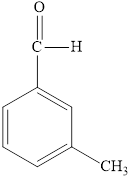
Concept explainers
(a)
Interpretation:The structure of 2-methylpentanal has to be drawn.
Concept Introduction :

In aldehydes, the carbonyl group is attached at the end of the hydrocarbon chain. The carbonyl carbon is bonded to atleast one hydrogen.
Aldehydes have a general formula of

(a)
Answer to Problem 71A
The structure of 2-methylpentanal is,

Explanation of Solution
The compound 2-methylpentanal is an aldehyde. Aldehydes are organic compounds that have a carbonyl carbon attached to atleast one hydrogen atom. The general formula of aldehyde is
The general structure of an aldehyde is,

Where,
In 2-methylpentanal,
The parent chain is pentane (five carbon atoms), since it is an aldehyde it becomes pentanal.
The carbonyl carbon occupies the first position
The substituent methyl is placed in the second position.
The structure of 2-methylpentanal is,

(b)
Interpretation: The structure of 3-hydroxybutanoic acid has to be drawn.
Concept Introduction :

In carboxylic acid, the second oxygen atom is attached to a hydrogen atom.
The general formula for carboxylic acid is
(b)
Answer to Problem 71A
The structure of 3-hydroxybutanoic acid is,

Explanation of Solution
The compound 3-hydroxybutanoic acid is a carboxylic acid. Carboxylic acid consist of carboxyl group. The general formula of carboxylic acid

Where,
In 3-hydroxybutanoic acid,
The parent carbon chain is butane (four carbon atoms), since it is a carboxylic acid, it becomes butanoic acid.
The carboxyl group occupies the first position and a hydroxyl group is attached in the third position.
The structure of 3-hydroxybutanoic acid is,

(c)
Interpretation:Interpretation:The structure of 2-aminopropanal has to be drawn.
Concept Introduction : Aldehydes contains the carbonyl group.

In aldehydes, the carbonyl group is attached at the end of the hydrocarbon chain. The carbonyl carbon has to be bonded to atleast one hydrogen.
Aldehydes have a general formula of

(c)
Answer to Problem 71A
The structure of 2-aminopropanal is,

Explanation of Solution
The compound 2-aminopropanal is an aldehyde.Aldehydes are organic compounds that have a carbonyl carbon attached to atleast one hydrogen atom. The general formula of aldehyde is
The general structure of an aldehyde is,

Where,
In 2-aminopropanal,
The parent carbon chain is propane (three carbon atoms), since it is an aldehyde, the name becomes propanal.
The carbonyl group occupies the first position and the substituent amino group is attached to the carbon at second position.
The structure of 2-aminopropanal is,

(d)
Interpretation:The structure of 2,4-hexanedione has to be drawn.
Concept Introduction:

In ketones, the carbonyl group is bond to two carbon atoms. The general formula of a ketone is

In a ketone, the carbonyl group is not present at the end of the hydrocarbon chain.
(d)
Answer to Problem 71A
The structure of 2,4-hexanedione is,

Explanation of Solution
The compound 2,4-hexanedione is a ketone. Ketones contain carbonyl group.

In ketones, the carbonyl group is bond to two carbon atoms. The general formula of a ketone is

Where,
In a ketone, the carbonyl group is not present at the end of the hydrocarbon chain.
In 2,4-hexanedione, there would be two keto groups (carbonyl groups) present the carbon-2 and carbon-4.
The parent carbon chain is hexane (six carbon atoms), since it is ketone consisting of two carbonyl groups, it is named as hexanedione.
The structure of 2,4-hexanedione is,

(e)
Interpretation:The structure of 3-methylbenzaldehyde has to be drawn.
Concept Introduction:Aldehydes contains the carbonyl group.

In aldehydes, the carbonyl group is attached at the end of the hydrocarbon chain. The carbonyl carbon has to be bonded to atleast one hydrogen.
Aldehydes have a general formula of

(e)
Answer to Problem 71A
The structure of 3-methylbenzaldehyde is,

Explanation of Solution
The compound 3-methylbenzaldehyde is an aldehyde.Aldehydes contain the carbonyl group.

In aldehydes, the carbonyl group is attached at the end of the hydrocarbon chain. The carbonyl carbon has to be bonded to atleast one hydrogen.
Aldehydes have a general formula of

Where,
In 3-methylbenzaldehyde,
The carbonyl group is attached to the benzene ring and the carbonyl group occupies the first position.
The substituent methyl group is attached to carbon in the third position.
The structure of 3-methylbenzaldehyde is,

Chapter 20 Solutions
World of Chemistry, 3rd edition
 ChemistryChemistryISBN:9781305957404Author:Steven S. Zumdahl, Susan A. Zumdahl, Donald J. DeCostePublisher:Cengage Learning
ChemistryChemistryISBN:9781305957404Author:Steven S. Zumdahl, Susan A. Zumdahl, Donald J. DeCostePublisher:Cengage Learning ChemistryChemistryISBN:9781259911156Author:Raymond Chang Dr., Jason Overby ProfessorPublisher:McGraw-Hill Education
ChemistryChemistryISBN:9781259911156Author:Raymond Chang Dr., Jason Overby ProfessorPublisher:McGraw-Hill Education Principles of Instrumental AnalysisChemistryISBN:9781305577213Author:Douglas A. Skoog, F. James Holler, Stanley R. CrouchPublisher:Cengage Learning
Principles of Instrumental AnalysisChemistryISBN:9781305577213Author:Douglas A. Skoog, F. James Holler, Stanley R. CrouchPublisher:Cengage Learning Organic ChemistryChemistryISBN:9780078021558Author:Janice Gorzynski Smith Dr.Publisher:McGraw-Hill Education
Organic ChemistryChemistryISBN:9780078021558Author:Janice Gorzynski Smith Dr.Publisher:McGraw-Hill Education Chemistry: Principles and ReactionsChemistryISBN:9781305079373Author:William L. Masterton, Cecile N. HurleyPublisher:Cengage Learning
Chemistry: Principles and ReactionsChemistryISBN:9781305079373Author:William L. Masterton, Cecile N. HurleyPublisher:Cengage Learning Elementary Principles of Chemical Processes, Bind...ChemistryISBN:9781118431221Author:Richard M. Felder, Ronald W. Rousseau, Lisa G. BullardPublisher:WILEY
Elementary Principles of Chemical Processes, Bind...ChemistryISBN:9781118431221Author:Richard M. Felder, Ronald W. Rousseau, Lisa G. BullardPublisher:WILEY





